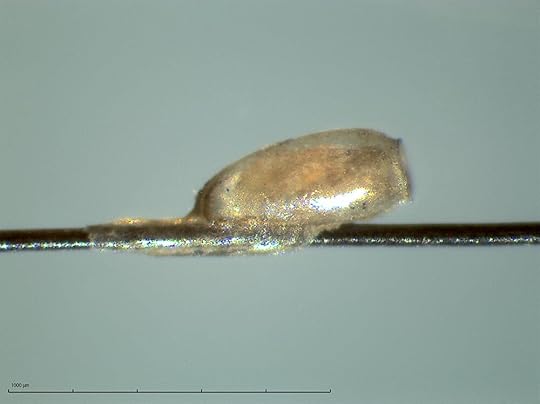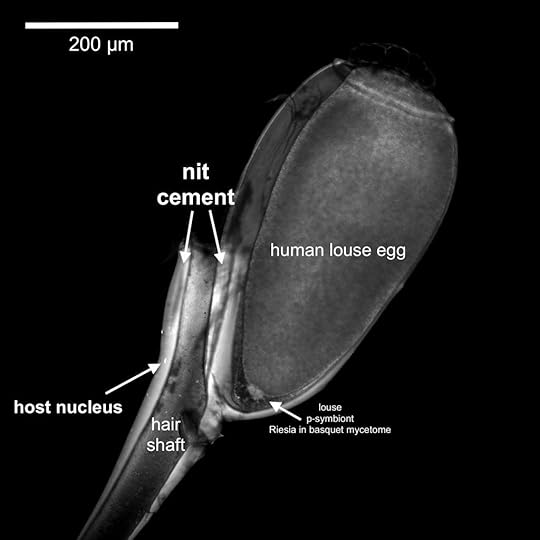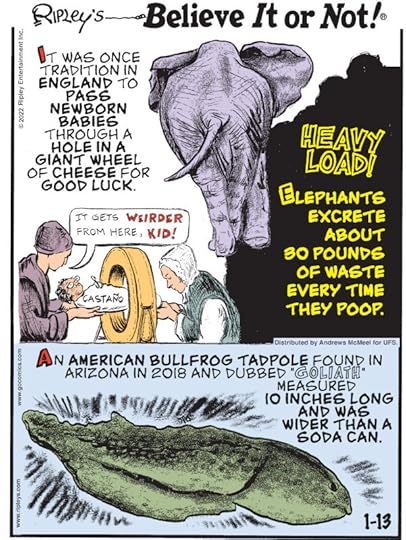Ripley Entertainment Inc.'s Blog, page 107
January 15, 2022
CARTOON 01-15-2022
January 14, 2022
Sea Lion And Seal Buck Mother Nature To Forge Their Own Paths
Featured in Ripley's Believe It or Not!

There seems to be a “choose your own adventure” trend emerging amongst the aquatic community, with this week’s news featuring multiple tails of sea lions and seals ditching their native waters to forge their own paths from sea to shining sea!
Sea Lion Goes Barking Mad for TravelIf you’ve ever wondered why the sea lion crossed the road, look no further than San Diego’s Route 94, where one flippered Eagles fan decided to hit the road to the Hotel California on his way to the other tide!
According to the California Highway Patrol, 911 dispatchers began receiving reports from drivers flipping out at the sight of the 200-pound sea lion about eight miles away from the nearest shoreline around 9:30 in the morning on January 7. Several passing cars stopped to direct rush hour traffic around the atypical tourist until the rescue team from SeaWorld San Diego arrived to take it to safety.
It took three large nets to capture the sea lion before guiding it into a large container and transporting him straight to the vet for a full physical.
A supervisor from the rescue crew, Jeni Smith, reported that while they do not know what led the sea lion astray, this wasn’t the hitchhiker’s first rodeo. The SeaWorld team rescued the same sea lion back in November after the juvenile male was found on Harbor Island Drive. He has since been spotted in other odd locations — albeit usually near the shores.
All’s well that ends well for this adventurous guy, with SeaWorld’s social media accounts reporting on Tuesday that he is “alert, eating well, active, and exhibiting normal sea lion behavior.” You can even watch him splash around at their facility via Instagram!
Home is Where the Heart IsMeanwhile, kayakers reported a seal spotting in the Hudson River on January 1, about 100 miles away from its natural habitat, only to learn that they were paddling around its chosen home.
While humans escape to Upstate New York to escape the hustle and bustle of the city, it’s not every day residents encounter a saltwater dweller — that is until Harbor Seal 246 swam along.
‘Unprecedented’: Seal seems to have made the Hudson River around Saugerties its home https://t.co/tXInUzxQ3P
— Daily Freeman (@DailyFreeman) January 4, 2022
Though born and abandoned in Lower Goose Island, Maine, Harbor Seal 246 was just a few days old when he was first rescued by Connecticut’s Mystic Aquarium Animal Rescue Program on April 28, 2018.
After being tagged and released into the wild Rhode Island waters in January 2019, the seal ditched the path of least resistance (the ocean), choosing to swim up the Connecticut River instead. With the Holyoke Dam in his way, 246 made a U-turn, floating down into the Long Island Sound before pivoting into the Hudson River.
The juvenile seal first made his way to Esopus Creek, near Saugerties Lighthouse, in August 2019, where he remained for 620 days until mysteriously disappearing on April 24, 2021 — his third birthday!
The seal resurfaced a few months later when he became infected with “seal pox” during his big swim to Long Island’s shores.After a few months in the New York Marine Rescue Center, he was, yet again, freed to swim the high seas — except he had other plans.
In an “unprecedented” move, Harbor Seal 246 eschewed his marine habitat yet again, opting to swim 210 miles back up the long and winding Hudson River until stopping right back at his beloved creek in August, where he has been swimming gleefully ever since.
“It is a story like none we have ever heard of. . . a marine mammal showing such extended affinity and fidelity to freshwater,” said the state Department of Environmental Conservation’s Hudson River Almanac’s Tom Lake in an email Monday.
By Meghan Yani, contributor for Ripleys.com
EXPLORE THE ODD IN PERSON! Discover hundreds of strange and unusual artifacts and get hands-on with unbelievable interactives when you visit a Ripley’s Odditorium!Source: Sea Lion And Seal Buck Mother Nature To Forge Their Own Paths
CARTOON 01-14-2022
January 13, 2022
Cat Food Made From Silkworm Pupae Promises Less-Stinky Poo
Featured in Ripley's Believe It or Not!

As any cat owner can attest, our feline friends are discerning creatures. One moment, they’re sneaking the side-eye as they watch a midnight fridge raid from afar and the next, they’re pouncing on a spider as though it’s an incredible delicacy – the enigmatic life of the average kitty. And while some of their behaviors can be chalked up to mystery, a few things always stay the same including their daily visits to the litter box.
Though cleaning up after the cat is not exactly a pleasant chore, researchers have found that with the help of one peculiar ingredient – silkworm pupae – this otherwise smelly task is moving a bit closer to an odorless ordeal!
The Health Benefits of Eating (The Right) BugsBefore we dive into the feline side of the study, it’s important to know the benefits bugs can have on our daily diet! Insects can actually be very valuable sources of nutrition. In fact, many kinds of creepy crawlies are considered delicacies around the world. They’re reportedly rich in vital minerals and nutrients such as zinc and iron, not to mention being a far more environmentally friendly element of the human diet versus common alternative sources of these nutrients. A reported minimum of two billion people regularly eat insects!

The Food and Agriculture Organization of the United Nations reports that there is, on average, more iron in locusts than in the same amount of beef. As with any diet, it’s important to choose your buggy buffet carefully, but some insect snacks can prove a very healthy snack indeed.
Even with all this in mind, the news of cat food made from the pupae of silkworms is an incredible step. Let’s take a look at how bold researchers in Taiwan have developed this delectable new kitty treat.
Silkworm Pupae: The Latest Dietary Trend for The Discerning Cat About TownEmbed from Getty Imageswindow.gie=window.gie||function(c){(gie.q=gie.q||[]).push(c)};gie(function(){gie.widgets.load({id:'9XC02OP8Tu1xgSbgrkqswA',sig:'LKJ4JKIAmXlDiIl7odGzSl1QCh9ehSUhN7txqnh9GlM=',w:'594px',h:'396px',items:'1236467501',caption: true ,tld:'com',is360: false })});
Typically, cats favor a meaty diet featuring the likes of turkey, chicken, and, famously, fish. So what do the pupae of silkworms have to offer that their familiar food doesn’t? Not only will silk farmers benefit from this swap, but it’s reportedly healthier for the cat! Felines that have eaten the buggy food appear to have more energy during their day-to-day lives, as well.
The insect-based diet also comes with an unusual bonus for the owner: the cat’s poop won’t smell as bad (a genuine concern for even the most adoring cat owners at times). The silkworm food helps the kitty’s stomach to deal with unfriendly bacteria, resulting in less smelly results.
The pupae’s journey to becoming the next hit kitty food starts at the Miaoli Agricultural Research and Extension Station. A reported 136 different species of silkworm call the station home, and the high protein content of the wiggly critters was already known. As a food source, the pupae become much more than just a waste product of silk manufacturing, an industry that, like many others, has faced devastating challenges over the past few years.
Embed from Getty Imageswindow.gie=window.gie||function(c){(gie.q=gie.q||[]).push(c)};gie(function(){gie.widgets.load({id:'Hb_L6OvRTtNarYSqQuPAMg',sig:'pZ49f7YnHmhh3SyKUr3agGSTHqVQs4v9r_n8D0FN34s=',w:'594px',h:'396px',items:'1236467459',caption: true ,tld:'com',is360: false })});
The concept is not so novel, generally speaking, as dried silkworm pupae are a mainstay for feeding animals such as birds and fish. The extraordinary thing is the way it was adapted to suit the different diets of our canine and feline friends. After all, kitties will have their familiar favorites like anyone else, and silkworm pupae are sure to have a rather different flavor to the fish or fowl they’re accustomed to.
The solution to this was an easy one: seasoning the buggy cat food with beef or tuna flavors would naturally make for a more appealing meal for our pets. A familiar taste, plus Omega-3 and other vital nutrients? This fascinating new product really could be the wave of the future.
What Are the Benefits of This Innovative New Food?As climate change and other concerns continue to affect the way we live, sustainability becomes more and more important. Meat consumption can be devastating to the environment, on a scale that some may not consider. In fact, a 2021 study showed that the production of plant-based foods produced only half the carbon emissions of the production of meat for food.
If insects can provide more valuable nutrients than their conventionally meaty alternatives, while also being made to taste like the familiar diets our cats and dogs already enjoy, where’s the harm in that? And if the dreaded litter tray can even be made a little less unpleasant in the process, that’s something that many pet owners will be able to get on board with.
At Taiwan’s Mao Thai Thai cat café, cats sampling the product reportedly responded positively. Manager Rosa Su said, “They have more energy and less smelly feces,” so early signs are that the product will deliver on its astonishing promises and could be a huge success.
Embed from Getty Imageswindow.gie=window.gie||function(c){(gie.q=gie.q||[]).push(c)};gie(function(){gie.widgets.load({id:'b0Emj6bKRB1tJRfYYXfx-g',sig:'xina6iNSIQL55DdOgVHUXtNbORtjOu1EBg9z-xb7dVc=',w:'594px',h:'396px',items:'1236467448',caption: true ,tld:'com',is360: false })});
Mass production has started rolling out in the country, and nations as varied as Japan and the United States have been considering getting on board too. It reportedly costs the equivalent of $2.43 for a tin of silkworm cat food, and the benefits, in areas from the environment to kitty health, should more than offset the slightly higher-than-average price.
By Chris Littlechild, contributor for Ripleys.com
EXPLORE THE ODD IN PERSON! Discover hundreds of strange and unusual artifacts and get hands-on with unbelievable interactives when you visit a Ripley’s Odditorium!Source: Cat Food Made From Silkworm Pupae Promises Less-Stinky Poo
CARTOON 01-13-2022
January 12, 2022
Tricks From His Teeth! Hanging With The Iron Jaw, Amadeus Lopez
Featured in Ripley's Believe It or Not!

There’s something to be said about the nostalgia brought upon spectators when they step foot inside the circus. Children marvel at the flight of trapeze artists suspended at uneasy heights and soaring through the air, while adults – the young at heart – wonder how it could all be possible.
From the tightrope walkers to the acrobats, it’s hard to believe that the human body is capable of such feats. And just when we think we’ve seen it all, someone proves us wrong with yet another daring act. “Someone” is Amadeus Lopez, and his act is The Iron Jaw.
Silks, Straps, and The Iron JawAmadeus Lopez discovered his love for the circus as a young adult. His university offered a course in the art of silks where he learned the technicalities and discipline of this suspended skill. And as his precision grew, so did his curiosity. He continued discovering new ways to improve his craft and eventually moved to the aerial straps.
Once he felt comfortable on this acrobatic apparatus, he was constantly looking for ways to improve and other classic acts to try his hand (foot? mouth?) at performing. Amadeus learned of the historical circus act known as “The Human Butterfly,” or “The Iron Jaw.”
A Soaring Start Above the CircusThis nail-biter of an act involves gripping a piece of leather between the teeth and being lifted by rope high up into the air. A notable performer of the Iron Jaw, and perhaps one of the very first, was the “Queen of the Antilles,” AKA Leona Dare. Dare was famous for her stunts on the trapeze and hanging from balloons mid-air! In 1872, she was a member of the Joel E. Warner circus where she debuted the Iron Jaw.
Not only was she lifted into the air hanging from her teeth, but oftentimes, she was responsible for holding on to other performers in this fashion, as well! During a show that same year, she was suspended under a hot-air balloon for the first time where she simultaneously lifted her husband off the ground, holding him by the waist using only her teeth. The daring acts of Miss Leona Dare certainly paved the way for other aerialists to follow.

Newspaper advertisement for Leona Dare’s ascents from Crystal Palace in London
Back in 1926, 16-year-old Guy Blackburn joined the Christy Bros. traveling circus. While on the road with this group, he performed intricate acts high above the crowd in the peaks of the tent. From the trapeze to the cloud swing to swinging ladders, he truly knew how to take his acts to new heights with great strength and showmanship. But perhaps the greatest spectacle, and possibly most physically taxing, of all was the Iron Jaw.
And, as if the static portion of the act wasn’t enough to make one’s heart skip a beat, Blackburn added a spin variation known as the “whirl of death.” This involved attaching an electric motor to the bit, causing it to spin up to 500 times per minute!
Amadeus and The Iron JawToday, very few aerialists have perfected and chosen to perform the dangerous mouth-hanging act, but Amadeus is focused on the extraordinary. Not only does he perform the Iron Jaw in its “simplest” – we use that term loosely – form, but he tacks on the addition of combination tricks.
Using his feet and hands, he holds three rubber balls while suspended below a basketball hoop. Two of the balls are spinning, balanced atop his fingers. He secures the third ball between his foot and shin before hoisting it through the air and into the hoop above his head – and don’t forget, he does it all while hanging from his teeth!
Like those who came before him – the iconic Leona Dare – Amadeus brings other performers into the mix. Doubling down on the daring and extraordinary, Amadeus holds others using his Iron Jaw (though it looks more like a jaw of steel) mid-act, as well! Shown below, you’ll find him alongside hair-hanging aerialist, Erin Blaire.
View this post on Instagram
A post shared by AMADEUS LOPEZ • Aerealist (@amadeus_lopez)
What’s most admirable about Amadeus is his persistence and drive to improve. While many would opt to stop at the act of the Iron Jaw alone, Amadeus is constantly looking for ways to evolve his act, making each performance even more nerve-racking and exhilarating than the last.
Take Your Own Step Out of the Box!While the Iron Jaw or hair-hanging might not be at the top of your must-try list, there are limitless possibilities for what you can accomplish next. Step Out of the Box with more inspiring, striking, and motivating stories inside the pages of Ripley’s newest annual, Out of the Box!
STEP OUTSIDE OF YOUR COMFORT ZONE Experience the stories of adventurers near and far, from a three-year-old mountain climber to hair-hangers and acrobats. Leave inspired by unbelievable talents, breathtaking bucket list-worthy locations, and curious discoveries, all from people just like you as you uncover the pages of Ripley’s newest annual book!Source: Tricks From His Teeth! Hanging With The Iron Jaw, Amadeus Lopez
CARTOON 01-12-2022
January 11, 2022
Unhappy Wife? Happy Life! The Show That Made Women “Queen For A Day”
Featured in Ripley's Believe It or Not!

In the mid-1900s, a popular TV show created a spectacle for the American public by exploiting women’s tragedies and shaming some of them for being poor. The program, Queen for a Day, justified its actions by giving these down-and-out mothers, widows, and other downtrodden women gifts such as kitchen appliances and dubbing them “queen for a day.” It was one of America’s first reality shows that entertained the middle class by zoning in on the problems families on the poverty level had to cope with.
Each episode featured four or five women who would compete to win the title by telling their sob stories. Their issues could range anywhere from needing a wheelchair for a child with cerebral palsy to trying to support a family after a husband’s death. In one episode, a contestant named Lili Meier won Queen for a Day after revealing she was a survivor of Auschwitz. According to the Washington Post, her wish was granted. Show executives connected her with a plastic surgeon to remove the tattoo she had on her forearm that she received in the concentration camp.
Meier won the episode because she got the best response and most claps by the Applause Meter. Contestants typically received what they asked for as well as several prizes supplied by the show’s sponsors. The winner was also dressed in a fancy cape and crown and treated to a version of “Pomp and Circumstance,” according to History.com.
Embed from Getty Imageswindow.gie=window.gie||function(c){(gie.q=gie.q||[]).push(c)};gie(function(){gie.widgets.load({id:'aKSHuLbLT6JV_K4HbIC-oQ',sig:'1eRq7mpxcRC7RlzEKmtGpjtEXycrK1d0lXgbMlK-Gtc=',w:'482px',h:'594px',items:'517820120',caption: true ,tld:'com',is360: false })});
The series was initially broadcast on radio before transitioning to television and aired from 1945 to 1964. In its first years of production, fewer than 50 percent of all American households had a TV, and families who did tended to be better off financially, making the show “poverty porn” for their viewing pleasure, reports Timeline.
The host, Jack Bailey, interviewed each contestant, and they provided the information that would later be judged by the studio audience. The women also revealed what type of product would help improve their lives, such as a new car to take a disabled child to much-needed doctor appointments or a washing machine to accommodate a large family. One contestant asked for beds so her children didn’t have to share a single sleeping bag, while another requested a gurney to bring her son with polio outside for fresh air.
The women were genuinely in need of help, and in retrospect, it can be uncomfortable to watch them sweat, fidget, and break down on set. Producers sought the best tear-jerking stories they could find, but they had their limits. Women who were victims of abuse, divorce, or morally ambiguous issues such as infidelity did not make the cut. And Bailey pressured the contestants not to cry on the program. Once he told a contestant, “Quit shaking! What’s wrong with you?”
At its core, the show was designed to promote consumerism, according to Josh Shepperd, assistant professor of Media Studies at the University of Colorado Boulder and Sound Fellow of the Library of Congress National Recording Preservation Board. After World War II, products such as kitchen appliances became increasingly more available, and women were largely responsible for purchasing decisions in the home. Producer Howard Blake once revealed that in order to get on the show contestants had to wish for something the program could promote, such as a new stove, a vacation, or baby food.
In order to receive her prize, a woman essentially had to humiliate herself in front of a TV audience. However, while the show certainly exploited its contestants, it told women’s stories of hardship at a time when men’s post-war lives were often in the spotlight and housewives were largely portrayed as happy, fulfilled homemakers.
According to Nostalgia Central, producer Howard Blake recalled in 1966: “Sure, Queen for a Day was vulgar and sleazy and filled with bathos and bad taste. That was why it was so successful; it was exactly what the general public wanted.”
By Noelle Talmon, contributor for Ripleys.com
EXPLORE THE ODD IN PERSON! Discover hundreds of strange and unusual artifacts and get hands-on with unbelievable interactives when you visit a Ripley’s Odditorium!Source: Unhappy Wife? Happy Life! The Show That Made Women “Queen For A Day”
Head Lice: Keepers Of Ancient History
Featured in Ripley's Believe It or Not!

When it comes to nuisances from the parasitic insect realm, lice hold an uncontested place near the top. Especially for parents of school-aged kids. There’s nothing like the mad dash to the pharmacy for pesticide-laced shampoos and fine-toothed combs to get rid of the nasty white critters. It’s safe to say, most of us see few redeeming features when it comes to these minuscule pests. But a new study may rewrite how we perceive the usefulness of nits.
A group of researchers from the University of Reading has added an incredible new resource to their toolkit for understanding human history: the analysis of “cement” head lice, a byproduct of everybody’s least favorite itchy infestation. And like the mosquitos frozen in amber that fueled Jurassic Park by preserving the blood of dinosaurs, human DNA samples can be retrieved from this so-called “cement,” paving the way for a new, unprecedented understanding of the people who came before us.
A Tantalizing Window Into the PastDespite the passage of between 1,500 and 2,000 years, archaeologists have recovered a residue known as cement head lice from the remains of ancient South Americans. Cement head lice refers to the substance used by nits to adhere their egg sacks to a host’s hair. This parasitic construction material includes cells from the host’s scalp and provides astonishing details about the health, demographics, and lives of some of our itchy-scalped predecessors.

Photo: University of Reading
This discovery has come at an opportune time. Now more than ever, demand has increased for DNA samples from our early forebearers. But ascertaining this material isn’t the easiest proposition. What’s more, the quality of the genetic material doesn’t prove equal across all specimen types. This begs the question: How does the genetic material recovered from cement head lice stand up to the competition? In a word, it’s remarkable.
What Nits Can Tell Us About Our AncestorsAccording to Mikkel Winther Pedersen of the University of Copenhagen, “The high amount of DNA yield from these nit cements really came as a surprise to us, and it was striking to me that such small amounts could still give us all this information about who these people were, and how the lice related to other lice species but also [gave] us hints to possible viral diseases.”

Photo: Universidad Nacional de San Juan
But the fantastic finds don’t stop there. Researchers have also gathered information about where the people lived, the climate, and overall pictures of their health. For example, analyzing nit cement has permitted scientists to determine the gender of each human host and to make linkages with other ancient people groups, including residents of Amazonia alive two millennia ago. They also found evidence of skin cancer trapped in the lice cement of one individual, which has already led to the fascinating hypothesis that lice might spread skin cancer.
Fleshing Out Our Knowledge of the PastExamining the DNA trapped by the nits in their hair cement also confirmed the migration pattern long-established of people groups moving from the North Amazonian plains to the San Juan Andes. And researchers were even able to determine a likely cause of death: exposure to extremely frigid temperatures. How did they figure this out? By the distance of the lice from the heads of their hosts. The smaller the gap, the colder the outside temperatures.

Photo: University of Reading
The wealth of information gleaned from analyzing nit cement holds excellent potential for future archaeological studies. After all, humans and lice have cohabited the same environments for millennia. Researchers have high hopes for further studies of lice biology and the extraordinary ancient evidence it contains.
By Engrid Barnett, contributor for Ripleys.com
EXPLORE THE ODD IN PERSON! Discover hundreds of strange and unusual artifacts and get hands-on with unbelievable interactives when you visit a Ripley’s Odditorium!CARTOON 01-11-2022
Ripley Entertainment Inc.'s Blog
- Ripley Entertainment Inc.'s profile
- 52 followers








